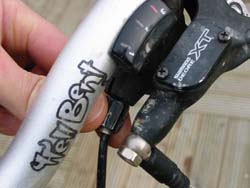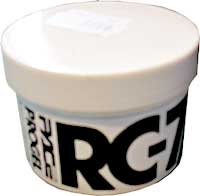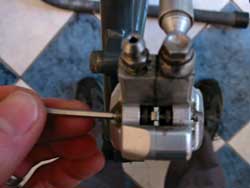Shifters don’t actually need replacing all that often. There are two circumstances that demand replacement, however. If they break, chances are you’ll need new ones. There’s a lot of bits inside a RapidFire unit and trying to repair one is liable to drive you insane. GripShift units are mechanically simpler, but most of the things that can break are substantial enough that it’s easier to replace the whole thing. The other reason to change shifters is if you’re increasing your gear count. You need the same number of clicks in your shifter as sprockets on your cassette…
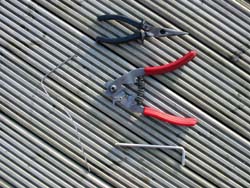 1. The 5mm Allen key always seems to crop up in the required tools. We’re dealing with cables here too, so you’ll need pliers and good cable cutters. And the humble bent spoke will deal with your grips.
1. The 5mm Allen key always seems to crop up in the required tools. We’re dealing with cables here too, so you’ll need pliers and good cable cutters. And the humble bent spoke will deal with your grips.
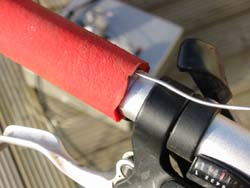 2. First step is to take the old shifters off. To do this you’ll need to get the grips off. Work an old spoke between the grip and the bar, spray some lube in there and work the spoke round until the grip can be slid off. If your grips have closed ends you’ll need to loosen the clamp bolts on the shifter and brake lever and move them inboard a little so you can make with some spoke action from the inside of the grip.
2. First step is to take the old shifters off. To do this you’ll need to get the grips off. Work an old spoke between the grip and the bar, spray some lube in there and work the spoke round until the grip can be slid off. If your grips have closed ends you’ll need to loosen the clamp bolts on the shifter and brake lever and move them inboard a little so you can make with some spoke action from the inside of the grip.
 3. You’ll probably find it easiest to unthread the gear cables while the shifters are still on the bars. In theory you can reuse the gear cables, but since you generally get a new set with the new shifters you might as well replace the lot. Undo the cable clamp bolts on the mechs, unthread the cables and take all the bits of housing off. Put the housings to one side, you’ll need them in a minute.
3. You’ll probably find it easiest to unthread the gear cables while the shifters are still on the bars. In theory you can reuse the gear cables, but since you generally get a new set with the new shifters you might as well replace the lot. Undo the cable clamp bolts on the mechs, unthread the cables and take all the bits of housing off. Put the housings to one side, you’ll need them in a minute.
 4. With the cables just dangling from the old shifters, you can slide them off the bars. RapidFire users will have to slide the brake levers off first. Then get your lovely shiny new shifters out of the box and slide them on to the bars. There’s no reason not to put the brake levers and grips back on at this stage, so put all that stuff back.
4. With the cables just dangling from the old shifters, you can slide them off the bars. RapidFire users will have to slide the brake levers off first. Then get your lovely shiny new shifters out of the box and slide them on to the bars. There’s no reason not to put the brake levers and grips back on at this stage, so put all that stuff back.
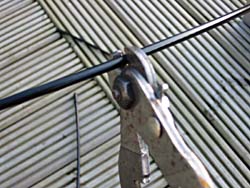 5. Find the handful of bits of cable housing that you took off and use them to measure off the right lengths for the new bits. Make sure there’s a ferrule on each end of every bit. If you’ve got a full susser or top-tube cable routing, you’ll probably find that you didn’t get quite enough housing with the new shifters, so either get a bit more (and some ferrules) from the shop or subtly recycle bits of the old stuff if it’s not too worn. Make sure you use decent cable cutters to cut the housing to length.
5. Find the handful of bits of cable housing that you took off and use them to measure off the right lengths for the new bits. Make sure there’s a ferrule on each end of every bit. If you’ve got a full susser or top-tube cable routing, you’ll probably find that you didn’t get quite enough housing with the new shifters, so either get a bit more (and some ferrules) from the shop or subtly recycle bits of the old stuff if it’s not too worn. Make sure you use decent cable cutters to cut the housing to length.
 6. If you’re not sure that the old bits of housing were the right length, offer them up to the frame and and cut them to length. For the bits running to the bars, make sure they’re long enough to allow you to turn the bars all the way to both sides. For the bit at the rear mech, ensure there’s a smooth curve between the stop and the mech adjuster. Any static lengths on the frame (the bit at the seat cluster on top-tube routed frames, for instance) should be as short as they’ll go while still following a smooth curve.
6. If you’re not sure that the old bits of housing were the right length, offer them up to the frame and and cut them to length. For the bits running to the bars, make sure they’re long enough to allow you to turn the bars all the way to both sides. For the bit at the rear mech, ensure there’s a smooth curve between the stop and the mech adjuster. Any static lengths on the frame (the bit at the seat cluster on top-tube routed frames, for instance) should be as short as they’ll go while still following a smooth curve.
 7. The cables will almost certainly already be fitted to the shifters, so just thread the end through all the cable housing and stops on the frame and clamp the end at the mech. Don’t overtighten the clamp just yet. Make sure all the housing is pushed right in to the stops on the frame and the adjusters at the mech and shifter. Then all that’s left is to set up the shifting on the rear and front mechs and the job’s done. Oh, except for finishing off the cable ends by crimping on some end caps. They’ll stop the cable unravelling.
7. The cables will almost certainly already be fitted to the shifters, so just thread the end through all the cable housing and stops on the frame and clamp the end at the mech. Don’t overtighten the clamp just yet. Make sure all the housing is pushed right in to the stops on the frame and the adjusters at the mech and shifter. Then all that’s left is to set up the shifting on the rear and front mechs and the job’s done. Oh, except for finishing off the cable ends by crimping on some end caps. They’ll stop the cable unravelling.



